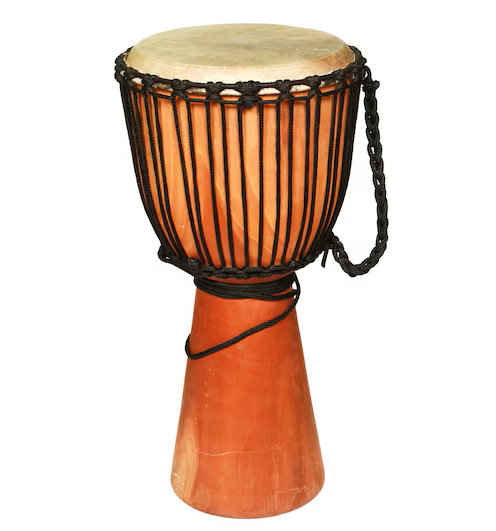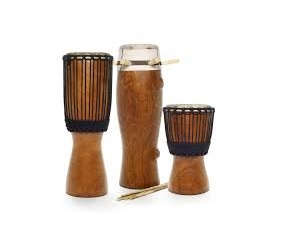Sabar
Percussions
Africa
Between 1001 and 1900 AD
Video
The Sabar is a traditional West African percussion instrument deeply rooted in the cultural heritage of the Wolof people of Senegal and The Gambia. This drum is not just a musical instrument but a vital element of storytelling, communication, and celebration within its community of origin. Known for its distinctive shape, vibrant sound, and energetic rhythms, the Sabar is a symbol of the rich musical traditions of West Africa, resonating across the continent and beyond.
Description of the Sabar
The Sabar is a tall, cylindrical drum that stands out due to its unique construction and playing style. It is traditionally carved from a single piece of hardwood, often from trees like mahogany or dimb. The drumhead is made of animal skin, typically goat stretched tightly over the open top. Its design is elegant and functional, with a narrow base that widens slightly as it rises toward the drumhead. The Sabar can vary in size, with some drums standing over three feet tall, while smaller versions are used for different purposes. Its slim build and lightweight structure make it relatively portable for performances and rituals.
Type of Instrument
The Sabar belongs to the percussion family and is classified as a membranophone. Membranophones are instruments that produce sound primarily through the vibration of a stretched membrane. The Sabar is unique in its dual playing style, as it is struck with one hand and a thin stick called a “galan.” This combination creates a diverse range of tones, from sharp, piercing cracks to deep, resonant booms, giving the Sabar its distinctive sound profile.
History of the Sabar
The origins of the Sabar can be traced back to West Africa, specifically to the Wolof people of Senegal and The Gambia. Its history dates back several centuries, with its earliest use believed to have emerged during the establishment of the Wolof kingdoms in the 13th and 14th centuries. The Sabar was historically used as a means of communication, particularly in rural areas where drumbeats were employed to convey messages over long distances. Different rhythms and patterns acted as a “talking drum,” transmitting messages about important events such as births, deaths, and community gatherings.
During the colonial period, the Sabar became a symbol of resistance and cultural identity. Despite attempts to suppress African traditions, the Wolof people preserved the Sabar’s rhythms, using it as a medium to maintain their cultural heritage. Over time, the Sabar transitioned from being solely a functional instrument to becoming an integral part of musical performances, storytelling, and dance.
Construction of the Sabar
The construction of the Sabar is a meticulous process, combining traditional craftsmanship with natural materials. The drum body is carved from a single log of hardwood, chosen for its strength and resonance. The log is hollowed out and shaped into its characteristic cylindrical form. The outer surface is often adorned with carvings or decorative elements that reflect the artisan’s skill and the cultural significance of the drum.
The drumhead is made from animal skin, usually goat, which is carefully prepared and stretched over the open top of the drum. The skin is secured using wooden pegs and rope, allowing for tension adjustments to achieve the desired pitch. The “galan” stick used to play the Sabar is crafted from flexible wood, such as bamboo, and is sized to fit comfortably in the player’s hand. The combination of these natural materials and expert craftsmanship results in an instrument that is both visually striking and acoustically rich.
Types of Sabar Drums
The Sabar family includes several types of drums, each serving a specific purpose within the ensemble. The main types include:
- Nder: The largest and most prominent Sabar drum, the Nder produces deep, resonant tones and often leads the ensemble.
- Mbéung Mbéung: A slightly smaller drum, known for its sharp and cutting sounds that provide rhythmic accents.
- Tama: Also known as the “talking drum,” the Tama is a smaller, hourglass-shaped drum that complements the Sabar ensemble.
- Tungune: A medium-sized drum that provides rhythmic support and bridges the sounds of the Nder and Mbéung Mbéung.
- Géél: A smaller Sabar drum, often used for intricate rhythms and embellishments.
Each drum in the Sabar ensemble has a unique voice and role, contributing to the complex and layered rhythms characteristic of Sabar music.
Features of the Sabar
The Sabar is distinguished by several unique features that set it apart from other percussion instruments. One of its most notable characteristics is its dual playing technique, combining hand strikes with the use of the galan stick. This technique allows for a wide range of tones and dynamic contrasts, from soft, muted sounds to loud, explosive beats.
The drum’s pitch can be adjusted by tightening or loosening the ropes that secure the drumhead, providing versatility for different musical contexts. The Sabar’s slender and tall design enhances its resonance, amplifying its sound in open spaces. Additionally, the intricate carvings and decorations on the drum’s surface reflect the cultural significance and artistic heritage of the instrument.
Sound Production of the Sabar
The Sabar produces sound through the vibration of its stretched drumhead when struck. The player uses one hand to slap the drumhead while simultaneously striking it with the galan stick. This combination creates a dynamic interplay of tones, including bass, slap, and open tones. The tension of the drumhead, the force of the strikes, and the position of the player’s hand all influence the quality of the sound produced.
The Sabar’s sound is characterized by its sharp, piercing quality, which allows it to cut through dense musical textures. Its tonal range and rhythmic flexibility make it suitable for solo performances, as well as for blending with other instruments in an ensemble setting.
Playing Methods of the Sabar
Playing the Sabar requires skill, precision, and a deep understanding of its rhythmic language. The drum is traditionally played while seated, with the instrument positioned between the player’s knees or upright on the ground. The player strikes the drumhead with their dominant hand and the galan stick, creating intricate rhythms and syncopated patterns.
The technique involves a combination of controlled hand slaps, finger taps, and stick strikes, each producing a distinct tone. Mastering the Sabar’s playing methods requires years of practice and training, often passed down through generations of drummers within the community. The ability to improvise and adapt rhythms to match the energy of the performance is a hallmark of skilled Sabar players.
Roles of the Sabar in Music
The Sabar plays a central role in West African music, serving as both a musical and cultural instrument. In traditional settings, the Sabar is used to accompany dance, storytelling, and ceremonial events. It is a key element in celebrations such as weddings, naming ceremonies, and religious festivals, where its rhythms energize participants and foster a sense of unity. In modern music, the Sabar has found a place in various genres, including Afrobeat, world music, and fusion. It is often featured in contemporary performances and recordings, showcasing its versatility and timeless appeal. The Sabar’s ability to convey complex rhythms and emotional intensity makes it a powerful tool for musical expression, bridging traditional and modern musical contexts.
Beyond its musical functions, the Sabar holds cultural significance as a symbol of identity and heritage for the Wolof people. It embodies the history, values, and traditions of its community, serving as a vessel for storytelling and a medium for preserving cultural memory. In this way, the Sabar transcends its role as a musical instrument, becoming a living testament to the enduring spirit of African culture.
FAQ
What is the origin of the Sabar musical instrument?
The Sabar drum originates from Senegal, West Africa, and is integral to the Serer people’s traditions. It dates back centuries and is traditionally used in ceremonies, celebrations, and storytelling. Its rhythms are also central to Senegalese dance and music styles. Today, it is widely recognized for its cultural and musical significance.
What materials are used to make the Sabar?
The Sabar drum is typically crafted from a hollowed-out log of hardwood, such as mahogany or dimbé. The drumhead is made from goat skin, which is stretched and secured using ropes or pegs. This combination produces the distinct, sharp tones characteristic of the Sabar. Its construction emphasizes both durability and sound quality.
What are the types of Sabar drums?
There are various types of Sabar drums, including the Nder, Lamb, and Tungune. The Nder is the largest and used for lead rhythms, while the Lamb produces mid-range tones. The Tungune is smaller and provides higher-pitched sounds. Together, these drums create a dynamic, layered rhythm in performances.
 Links
Links
References
Other Instrument
Categories



















